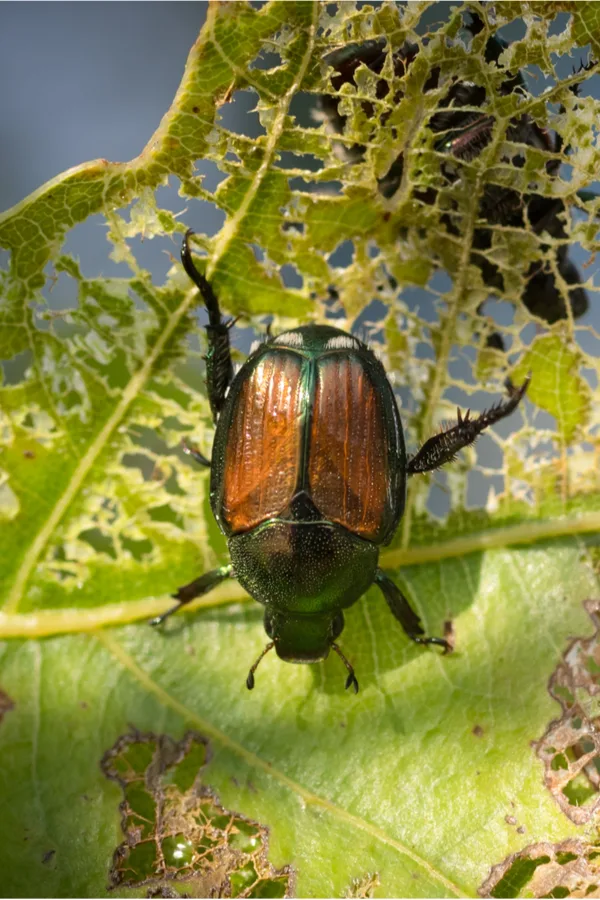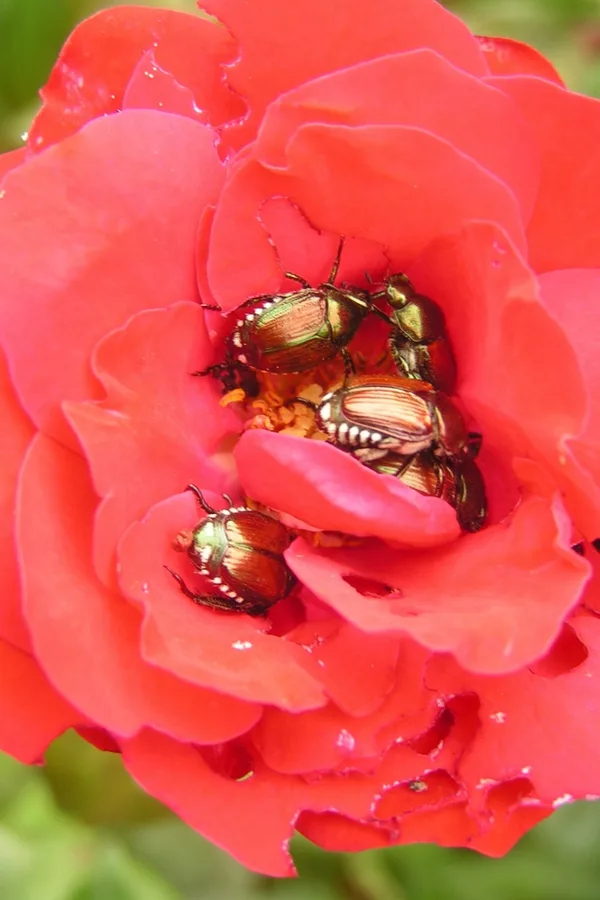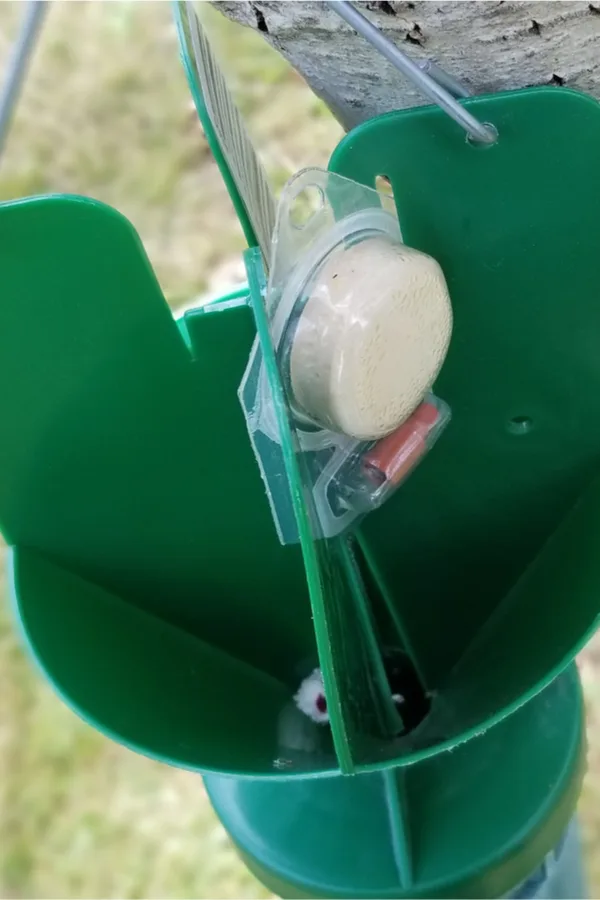Looking for a few great ways to stop Japanese Beetles in their tracks – and protect your plants, shrubs and bushes in the process?
As summer begins to hit full stride, so do many of the pests and insects that love to dine on the plants in your garden, flowerbeds and landscape. And at the top of the “trouble” list for many gardeners is the dreaded Japanese Beetle!
Japanese beetles are voracious eaters. Unlike many pests that attack only specific plants, they chew and devour foliage from nearly any species. Unfortunately, without a way to stop them, they can quickly decimate an entire landscape in just a few days.

The list of plant life that beetles will attack is lengthy. It includes vegetable plants, flowers, bushes, trees – and even some ornamental grasses and shrubs as well. And if the adult beetles were not bad enough, young beetles, known as grubs, wreak havoc in a different way.
Japanese Beetle grubs overwinter and live in the soil. In the early spring, before becoming an adult, they feed on the roots of lawns before emerging. In the process, they can damage turf, leaving behind brown or dying grass spots. Even worse, they attract ground moles, who love to tear up your yard looking for them!
But here’s the good news – with a few simple and natural methods, you can control Japanese beetles. And in the process, minimize or even eliminate the damage they cause.
How To Protect Plants From Japanese Beetles
Why Reaching For Pesticides Might Not Be The Best Option
For many gardeners, the first instinct might be to reach for pesticides at the first sign of beetles. And although some pesticides can be effective in killing Japanese beetles, they can also eliminate a whole slew of beneficial insects in the process. And that can lead to bigger problems.
Honeybees, butterflies and a long list of critical pollinators and beneficial insects are also killed off when pesticides are applied. Not only does it result in plants having less of a chance to be pollinated, it can result in opening the door for other pests to take over.

Under normal conditions, there is a good balance of insects, both good and bad for plants. The simple truth is, beneficial insects need a few aphids and other pests to dine on. Without that balance, there are few checks left to control insect populations naturally.
That is exactly why simply spraying to kill off one single species isn’t always the best long term solution – not at least when you realize just how many good insects it kills along with it!
Add in the concern of personal safety and health when using pesticides – especially in the vegetable garden or on any edible plants – and it just makes sense to take a more natural approach.
With that in mind, here are a few simple and all-natural approaches that work incredibly well in controlling Japanese beetles. True success really comes down to timing, persistence, and using the right approach!
How To Stop Japanese Beetles
Step 1: Hand Picking – How To Protect Plants From Japanese Beetles
The first line of defense against Japanese beetles may sound old-fashioned, but it works wonders. Believe it or not , hand-picking beetles off of plants and disposing of them in a bucket of soapy water is one of the most effective long-term solutions for control.

The majority of the Beetle population emerge from the ground to feed and mate over a two to three week period. By being prepared and picking them off early, you can stop the damage fast.
Even more, since they can’t complete the cycle by laying eggs back into the ground, you help control the following year’s population as well. A few years of hand picking can almost single-handedly reduce the issue.
For best results, pick in late morning to mid afternoon, when beetles are most active. If you can, make a round at each time. You will be surprised at how in just a week or so, the population will be under control.
Neem Oil – How To Protect Plants From Japanese Beetles
If hand picking simply isn’t an option, or if you have a severe issue, neem oil can be a good all-natural solution. When it comes to effective organic sprays that stop Japanese Beetles without harming other insects, neem oil is at the top of the list.
Neem oil is made by pressing the seeds from a neem tree. The resulting oil has long been known to be an incredible weapon against many pests. When mixed with water and sprayed onto plant foliage, it is fatal to beetles. But here is the good thing, – it will not kill bees, butterflies, ladybugs and many other beneficial insects.
To make, mix 4 teaspoons of neem oil with one gallon of water and a few drops of dish soap. The dish soap will help the mixture adhere to the foliage of plants. Product Link: Pure Neem Oil

Apply the mixture with a sprayer to evenly coat the leaves of plants. Spray weekly to maintain effectiveness. You will also need to reapply after it rains or if you are watering your plants. For more on neem oil, check out our article : How To Use Neem Oil – The Organic Solution To Pest & Disease Control.
Avoiding Beetle Traps / Lures – How To Protect Plants & Stop Japanese Beetles
So what about using beetle bags, traps and lures? Unfortunately, all of these can create more of a beetle problem in your yard by using them!
Beetle traps use a scented bag or liquid to lure beetles into a confined space in order to trap them. The scent works quite well in attracting the beetles. Actually, it works too well, attracting them from an even wide area!
In many cases, it results in multiplying issues with Japanese beetles problem many times over. And, of course, all of those extra beetles don’t always end up in the trap. Instead, they end up on all kinds of plants around the trap, causing additional harm to your landscape.
If you do choose to use beetle bags or traps, always locate them at the edge of your property. This will attract the beetles in your yard away and not to plants. This works best if you have a large yard. Unfortunately, small yards simply don’t have the space to keep beetles far enough away.

Controlling Grubs – How To Protect Plants From Japanese Beetles
Finally, it goes without saying that controlling Japanese beetle grubs is one of the best ways to stop adult Japanese beetle damage. After all, since beetles emerge as grubs from the soil, eliminating the grubs will eliminate the future beetles.
One of the best ways to kill grubs is with a simple solution of detergent and water spray. By mixing a few teaspoons of ordinary dish soap with a gallon of water, you can create a solution to spray directly on your lawn.
The soapy water forces grubs to come up out of the ground. And, when they do, they become easy targets for birds to feed on. This is great to do every few weeks from mid summer to early fall – before the grubs bury deep before winter.
Here it to controlling Japanese beetles in your landscape this year – naturally!
Follow Our Facebook Page For Great Gardening Tips And Advice! This Is My Garden Facebook Page
This Is My Garden is a garden website created by gardeners, for gardeners. Jim and Mary Competti have been writing gardening, DIY and recipe articles and books and speaking for over 15 years from their 46 acre Ohio farm. They publish three articles every week, 52 weeks a year. Sign up today to follow via email, or follow along!

